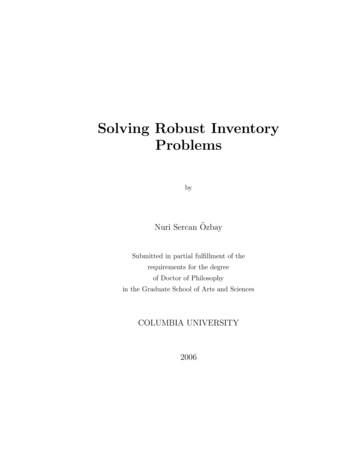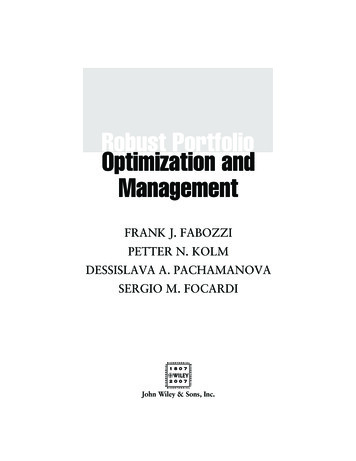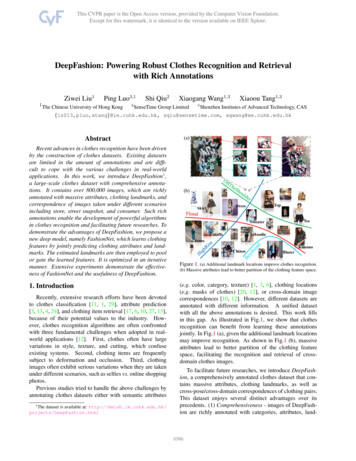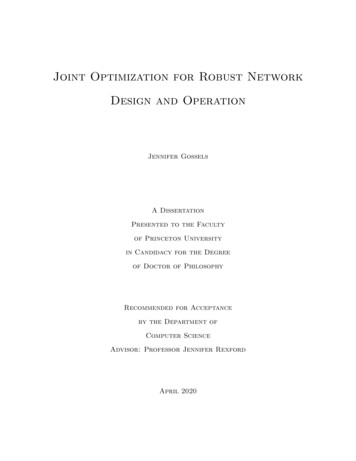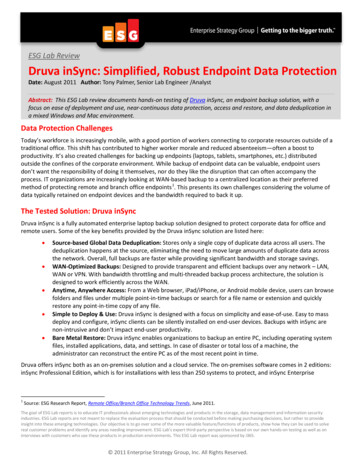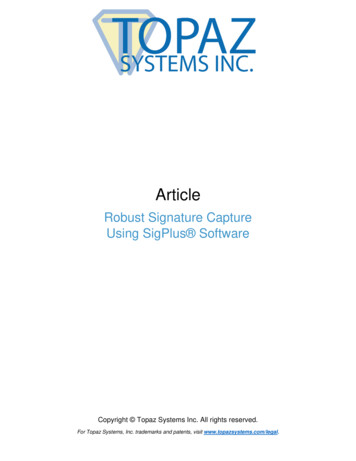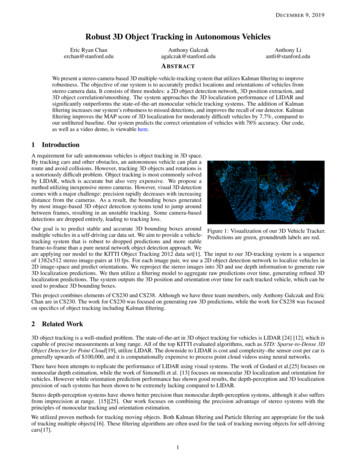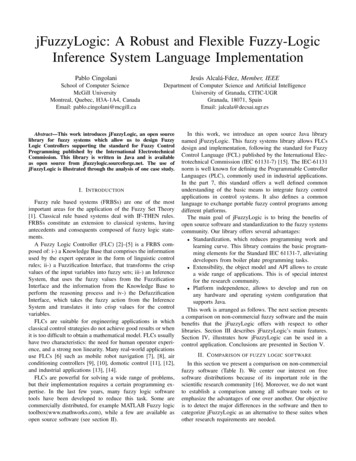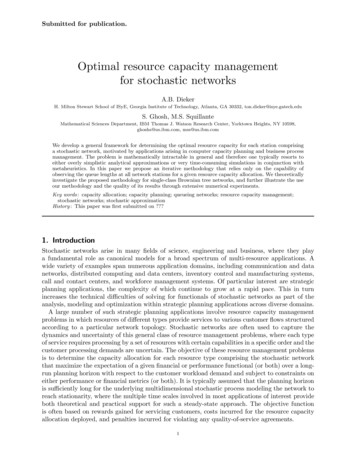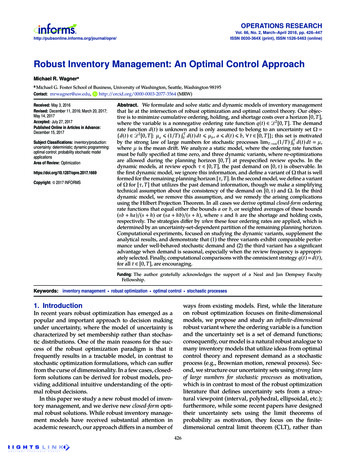
Transcription
OPERATIONS RESEARCHVol. 66, No. 2, March–April 2018, pp. 426–447ISSN 0030-364X (print), ISSN 1526-5463 /Robust Inventory Management: An Optimal Control ApproachDownloaded from informs.org by [128.95.104.109] on 17 March 2018, at 10:23 . For personal use only, all rights reserved.Michael R. Wagneraa MichaelG. Foster School of Business, University of Washington, Seattle, Washington 98195http://orcid.org/0000-0003-2077-3564 (MRW)Contact: mrwagner@uw.edu,Received: May 3, 2016Revised: December 11, 2016; March 20, 2017;May 14, 2017Accepted: July 27, 2017Published Online in Articles in Advance:December 15, 2017Subject Classifications: inventory/production:uncertainty: deterministic; dynamic programming:optimal control; probability stochastic modelapplicationsArea of Review: Copyright: 2017 INFORMSAbstract. We formulate and solve static and dynamic models of inventory managementthat lie at the intersection of robust optimization and optimal control theory. Our objective is to minimize cumulative ordering, holding, and shortage costs over a horizon [0, T],where the variable is a nonnegative ordering rate function q(t) 2 L 2 [0, T]. The demandrate function d(t) is unknown and is only assumed to belong to an uncertainty set {d(t) 2 L 2 [0, T]: µ a 6 (1/T) Ä0T d(t) dt 6 µ b , a 6 d(t) 6 b, 8 t 2 [0, T]}; this set is motivatedby the strong law of large numbers for stochastic processes limT!1 (1/T) Ä0T d(t) dt µ,where µ is the mean drift. We analyze a static model, where the ordering rate functionmust be fully specified at time zero, and three dynamic variants, where re-optimizationsare allowed during the planning horizon [0, T] at prespecified review epochs. In thedynamic models, at review epoch 2 [0, T], the past demand on [0, ) is observable. Inthe first dynamic model, we ignore this information, and define a variant of that is wellformed for the remaining planning horizon [ , T]. In the second model, we define a variantof for [ , T] that utilizes the past demand information, though we make a simplifyingtechnical assumption about the consistency of the demand on [0, ) and . In the thirddynamic model, we remove this assumption, and we remedy the arising complicationsusing the Hilbert Projection Theorem. In all cases we derive optimal closed-form orderingrate functions that equal either the bounds a or b, or weighted averages of these bounds(sb ha)/(s h) or (sa hb)/(s h), where s and h are the shortage and holding costs,respectively. The strategies differ by when these four ordering rates are applied, which isdetermined by an uncertainty-set-dependent partition of the remaining planning horizon.Computational experiments, focused on studying the dynamic variants, supplement theanalytical results, and demonstrate that (1) the three variants exhibit comparable performance under well-behaved stochastic demand and (2) the third variant has a significantadvantage when demand is seasonal, especially when the review frequency is appropriately selected. Finally, computational comparisons with the omniscient strategy q(t) d(t),for all t 2 [0, T], are encouraging.Funding: The author gratefully acknowledges the support of a Neal and Jan Dempsey FacultyFellowship.Keywords: inventory management robust optimization optimal control stochastic processes1. Introductionways from existing models. First, while the literatureon robust optimization focuses on finite-dimensionalmodels, we propose and study an infinite-dimensionalrobust variant where the ordering variable is a functionand the uncertainty set is a set of demand functions;consequently, our model is a natural robust analogue tomany inventory models that utilize ideas from optimalcontrol theory and represent demand as a stochasticprocess (e.g., Brownian motion, renewal process). Second, we structure our uncertainty sets using strong lawsof large numbers for stochastic processes as motivation,which is in contrast to most of the robust optimizationliterature that defines uncertainty sets from a structural viewpoint (interval, polyhedral, ellipsoidal, etc.);furthermore, while some recent papers have designedtheir uncertainty sets using the limit theorems ofprobability as motivation, they focus on the finitedimensional central limit theorem (CLT), rather thanIn recent years robust optimization has emerged as apopular and important approach to decision makingunder uncertainty, where the model of uncertainty ischaracterized by set membership rather than stochastic distributions. One of the main reasons for the success of the robust optimization paradigm is that itfrequently results in a tractable model, in contrast tostochastic optimization formulations, which can sufferfrom the curse of dimensionality. In a few cases, closedform solutions can be derived for robust models, providing additional intuitive understanding of the optimal robust decisions.In this paper we study a new robust model of inventory management, and we derive new closed-form optimal robust solutions. While robust inventory management models have received substantial attention inacademic research, our approach differs in a number of426
Wagner: Robust Inventory Management: An Optimal Control ApproachDownloaded from informs.org by [128.95.104.109] on 17 March 2018, at 10:23 . For personal use only, all rights reserved.Operations Research, 2018, vol. 66, no. 2, pp. 426–447, 2017 INFORMSstrong laws of large numbers for stochastic processes.Third, in contrast to most of the literature, we deriveclosed-form robust ordering rate functions for a basic staticmodel and dynamic variants of it, where the ordering rate function can depend on the currently observedinventory position function. Our model overlaps withexisting models in the following ways: we considerthe control of a single durable product over a finitehorizon, with no fixed ordering costs, zero lead times,and backordering allowed; we assume demand is astochastic process, where the mean (e.g., drift parameter of Brownian motion or mean interarrival time in arenewal process) is known, but any other parametersand relevant distributions (e.g., distribution of interarrival time) are not known. We next provide a literaturereview to describe more details and better position ourcontributions.1.1. Literature ReviewThe field of robust optimization has burgeoned inrecent years and we do not attempt to provide a comprehensive literature review. We point the interestedreader to Ben-Tal et al. (2009) for an overview. A similar statement can be made about inventory management, and we suggest (Zipkin 2000) as a primer onthis vast field. We focus our review on the papersmost related to our work, which concentrates on threestreams: (1) robust inventory management, (2) optimalcontrol of stochastic inventory systems, and (3) robustuncertainty sets motivated by the limit theorems ofprobability.The foundation of our paper can be found inBertsimas and Sim (2004), which introduce the notionof a “budget of uncertainty” to reduce the conservatismof robust optimization. Bertsimas and Thiele (2006)apply the ideas in Bertsimas and Sim (2004) to formulate a robust optimization model of inventory control, which can handle fixed costs, capacitated ordersand inventory, and network topologies. Bienstock andÖzbay (2008) generalize (Bertsimas and Thiele 2006) inmultiple directions and also analyze data-driven robustmodels, focusing on algorithmic issues. Mamani et al.(2016) study a similar inventory problem to that inBertsimas and Thiele (2006) and Bienstock and Özbay(2008), except that the uncertainty sets are motivatedby the CLT, and closed-form solutions, in both staticand dynamic contexts, are derived. Other researchershave studied robust inventory management from different perspectives. Chen et al. (2007) study genericrobust uncertainty sets allowing for asymmetry, resulting in a second-order cone counterpart and See and Sim(2010) analyze a “factor-based” model of uncertainty,which also results in a second-order cone program.Wagner (2010, 2011) study robust inventory management from the online optimization perspective. Morerecently, Ardestani-Jaafari and Delage (2016), building427upon the work of Gorissen and Hertog (2013), provideapproximation approaches for a broader class of robustoptimization problems involving sums of piecewise linear functions. Solyalı et al. (2016) propose a new robustformulation of inventory control based on ideas fromfacility location, which results in polynomial-time solvability when the initial inventory is negative or zero.Our paper differs from this finite-dimensional literaturestream in that we study an infinite-dimensional controltheoretic formulation, where the ordering strategy anddemand stream are represented by (Lebesgue squareintegrable) functions.All the aforementioned papers deal exclusively withfinite dimensional models. Many researchers haveinstead modeled stochastic inventory management as(nonrobust) stochastic optimal control problems, typically using either (1) Brownian motion or (2) renewalprocesses to model the evolution of demand. Harrisonet al. (1983) and Harrison and Taksar (1983) are someof the first to model storage systems using Brownianmotion, and they derive optimal control policies forsuch systems. Gallego (1990) utilizes Brownian motionto represent cumulative demand in an inventory management system. Jagannathan and Sen (1991) also utilize Brownian motion in an inventory model of bloodin a blood bank context. Wein (1992) approximates amake-to-stock production system as a dynamic control problem involving Brownian motion. Asmussenand Perry (1998) focus their study on an operatorcalculus for matrix-exponential distributions, but alsoapply their ideas to a (q, Q) inventory system driven byBrownian motion. Liu and Song (2012) study the (S, T)inventory policy under a variety of demand assumptions, including Brownian motion. Wu and Chao (2014)utilize two-dimensional Brownian motion to simultaneously capture correlated cumulative demand andproduction. Regarding renewal processes, Gallego andvan Ryzin (1994) utilize a price-dependent Poisson process to model demand. Rosling (2002) studies differentcost-rate models under a renewal process of demand.Plambeck and Ward (2006) and Plambeck (2008) utilize renewal processes to model cumulative demandin assemble-to-order systems. Federgruen and Wang(2015) also utilize a renewal process of demand in aninventory system with shelf-age dependent holdingcost and delay-dependent shortage cost. While we donot explicitly utilize Brownian motion or renewal processes in our paper, these stochastic processes motivatethe infinite-dimensional nature of our robust model.Furthermore, our work can be considered a robust analogue to these stochastic control-theoretic approachesto inventory management.We next discuss the design of robust uncertainty sets.Historically, these sets have been designed as eitherinterval-based, polyhedral, ellipsoidal, or, more generally, simply convex. However, recently researchers have
Downloaded from informs.org by [128.95.104.109] on 17 March 2018, at 10:23 . For personal use only, all rights reserved.428attempted to design uncertainty sets that capture salientcharacteristics of certain limit theorems of probability.The first example of such a work is Bertsimas et al.(2011), which analyzes queuing networks with a robustuncertainty set motivated by the probabilistic law of theiterated logarithm. Next, Bandi and Bertsimas (2012)provide an in-depth study of the use of CLT-style uncertainty sets; these sets have been applied to informationtheory by Bandi and Bertsimas (2011), option pricing byBandi and Bertsimas (2014b), auction design by Bandiand Bertsimas (2014a), and queueing theory by Bandiet al. (2015, 2016). More relevant to our paper is Mamaniet al. (2016), who studied robust inventory managementand whose design of uncertainty sets was also motivated by the CLT. Our paper differs from this literaturestream in that our uncertainty sets are motivated bystrong laws of large numbers for stochastic processes,rather than the finite-dimensional CLT or the law of theiterated logarithm.In our paper we consider both static models, wherethe entire ordering rate function must be specified attime zero, and dynamic models, where the orderingrate function can be updated as uncertain parameters are realized. We therefore also survey the recentwork on robust dynamic optimization. Ben-Tal et al.(2004) introduce an “adjustable” robust optimizationproblem, where some variables can be updated basedon realizations of uncertain parameters; these authorsprove that the general problem is NP-hard. This difficulty has motivated researchers to study approximations, usually an “affinely adjustable” robust optimization model, where the optimization is over the classof linear policies in the uncertain parameters. Ben-Talet al. (2005) study such a model in a supply chain context. Chen et al. (2008) utilize second-order cones toimprove upon the linear approximations in a genericmultiperiod problem. Georghiou et al. (2015) and Bertsimas and Georghiou (2015) study alternative approximations to the general adjustable robust optimizationproblem. Bertsimas et al. (2010) prove the optimality ofaffine policies for a general class of multistage robustoptimization models where random disturbances areconstrained to lie in intervals and are independent.Iancu et al. (2013) continue the study of affine policies,more fully characterizing the problem structures whereaffine policies are optimal in dynamic robust optimization. Mamani et al. (2016) study a rolling-horizonvariant of their basic static model, and show that itexhibits encouraging computational performance withrespect to Bertsimas and Thiele (2006) and Bertsimaset al. (2010). Solyalı et al. (2016) also propose a rollinghorizon variant of their static model whose computational pe
form solutions can be derived for robust models, pro-viding additional intuitive understanding of the opti- mal robust decisions. In this paper we study a new robust model of inven-tory management, and we derive new closed-form opti-mal robust solutions. While robust inventory manage-ment models have received substantial attention in academicresearch,ourapproachdiffersinanumberof ways from .
